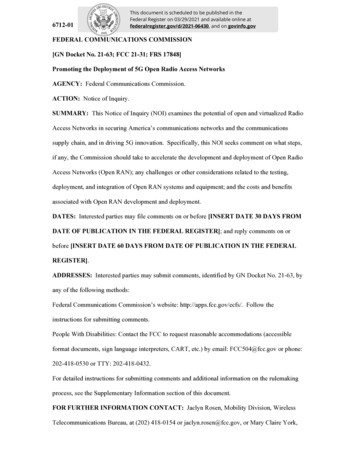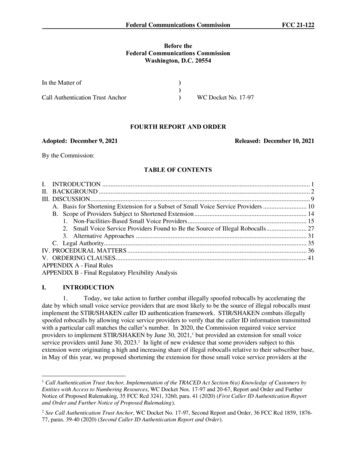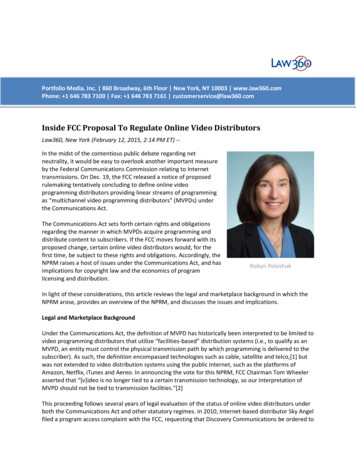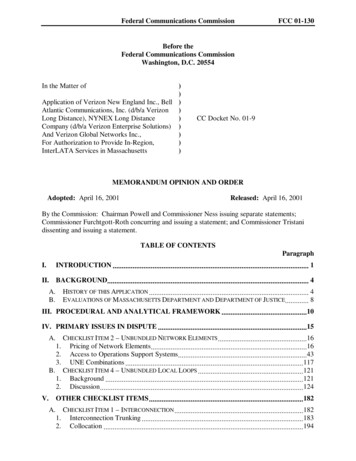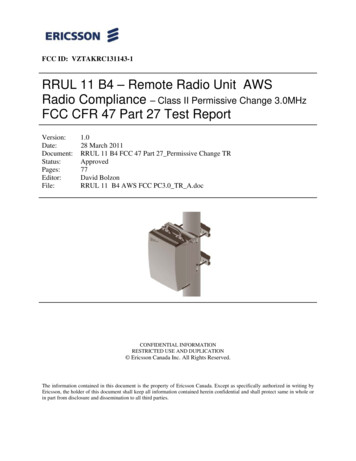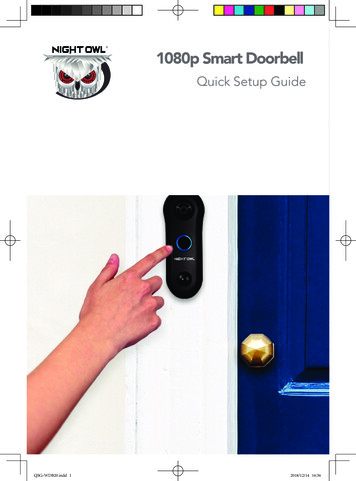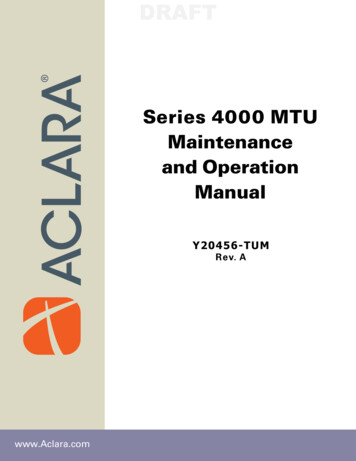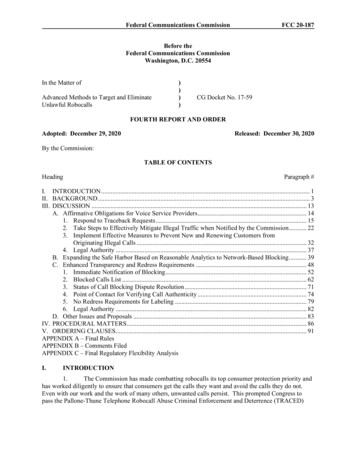
Transcription
Federal Communications CommissionFCC 20-187Before theFederal Communications CommissionWashington, D.C. 20554In the Matter ofAdvanced Methods to Target and EliminateUnlawful Robocalls))))CG Docket No. 17-59FOURTH REPORT AND ORDERAdopted: December 29, 2020Released: December 30, 2020By the Commission:TABLE OF CONTENTSHeadingParagraph #I. INTRODUCTION . 1II. BACKGROUND . 3III. DISCUSSION . 13A. Affirmative Obligations for Voice Service Providers. 141. Respond to Traceback Requests . 152. Take Steps to Effectively Mitigate Illegal Traffic when Notified by the Commission . 223. Implement Effective Measures to Prevent New and Renewing Customers fromOriginating Illegal Calls . 324. Legal Authority . 37B. Expanding the Safe Harbor Based on Reasonable Analytics to Network-Based Blocking . 39C. Enhanced Transparency and Redress Requirements . 481. Immediate Notification of Blocking . 522. Blocked Calls List . 623. Status of Call Blocking Dispute Resolution . 714. Point of Contact for Verifying Call Authenticity . 745. No Redress Requirements for Labeling . 796. Legal Authority . 82D. Other Issues and Proposals . 83IV. PROCEDURAL MATTERS . 86V. ORDERING CLAUSES. 91APPENDIX A – Final RulesAPPENDIX B – Comments FiledAPPENDIX C – Final Regulatory Flexibility AnalysisI.INTRODUCTION1.The Commission has made combatting robocalls its top consumer protection priority andhas worked diligently to ensure that consumers get the calls they want and avoid the calls they do not.Even with our work and the work of many others, unwanted calls persist. This prompted Congress topass the Pallone-Thune Telephone Robocall Abuse Criminal Enforcement and Deterrence (TRACED)
Federal Communications CommissionFCC 20-187Act.1 This new law directs the Commission to encourage voice service providers to block unwanted callsby giving them safe harbors for erroneous blocking based, in whole or in part, on caller ID authenticationinformation and to make it easier to identify and fix erroneous blocking. Today, we continue our work onthese fronts.2.In this Fourth Report and Order, we require voice service providers to meet certainaffirmative obligations and to better police their networks against illegal calls.2 We next expand ourexisting call blocking safe harbor to cover network-based blocking of certain calls that are highly likely tobe illegal. Third, we adopt rules to provide greater transparency and ensure that both callers andconsumers can better identify blocked calls and ensure those that are wanted are un-blocked, consistentwith section 10(b) of the TRACED Act. We also broaden our point-of-contact requirement to covercaller ID authentication concerns under section 4(c)(1)(C) of the TRACED Act.II.BACKGROUND3.The Commission receives more complaints about unwanted calls than any other issue.3The Federal Trade Commission (FTC)4 and non-governmental entities report similarly high numbers.5Unwanted calls can annoy, defraud, and lead to identity theft.6 In recent years, the Commission has1Pallone-Thune Telephone Robocall Abuse Criminal Enforcement and Deterrence Act, Pub. L. No. 116-105, 133Stat. 3274 (2019) (TRACED Act).2For purposes of this Fourth Report and Order, we use the definition of “voice service provider” that we adopted inthe Call Blocking Order and Further Notice. Specifically, “voice service provider” means any entity originating,carrying, or terminating voice calls through time-division multiplexing (TDM), Voice over Internet Protocol (VoIP),or commercial mobile radio service (CMRS). Advanced Methods to Target and Eliminate Unlawful Robocalls, CGDocket No. 17-59, Third Report and Order, Order on Reconsideration, and Fourth Further Notice of ProposedRulemaking, 35 FCC Rcd 7614, 7615 n.3 (2020) (Call Blocking Order and Further Notice). As we explained there,this definition is consistent with our use of this term in previous call-blocking actions and existing call-blockingrules, but is more extensive than the definition of “voice service” in section 4 of the TRACED Act and the FirstSTIR/SHAKEN Order; that definition excludes intermediate providers. See TRACED Act § 4(a)(2) (codified at 47U.S.C. § 227b(a)(2)) (2019); Call Authentication Trust Anchor, Implementation of TRACED Act Section 6(a)—Knowledge of Customers by Entities with Access to Numbering Resources, WC Docket Nos. 17-97 and 20-67, Reportand Order and Further Notice of Proposed Rulemaking, 35 FCC Rcd 3241, 3300-01, Appx. A (2020) (FirstSTIR/SHAKEN Order). We found that adopting the narrower definition used in the TRACED Act in this proceedingwould create inconsistency with our existing call blocking rules. To the extent that we rely on section 4 of theTRACED Act for some of the rules we adopt today, we have ensured that the subset of voice service providerscovered by those rules are included in the TRACED Act’s definition of “voice service.”3We received 185,000 such complaints in 2017, 232,000 in 2018, 193,000 in 2019, and 154,000 in 2020. FCC,Consumer Complaint Data Center, https://www.fcc.gov/consumer-help-center-data (last visited Dec. 20, 2020).Multiple factors can affect these numbers, including outreach efforts and media coverage on how to avoid unwantedcalls. Complaint numbers declined significantly during the first four months of the COVID-19 pandemic, reducingthe total number of complaints the Commission received in 2020.4In fiscal year 2019, the FTC received an average of 315,000 robocall complaints per month. FTC, Biennial Reportto Congress Under the Do Not Call Registry Fee Extension Act of 2007 at 3 do-not/p034305dncreport2019.pdf.5For example, Hiya reports that 54.6 billion unwanted robocalls were placed to U.S. mobile phones in 2019. Hiya,State of the Call, https://hiya.com/state-of-the-call (last visited Dec. 3, 2020). Similarly, YouMail estimatesrobocalls at 58.5 billion for 2019. YouMail, Historical Robocalls By Time, https://robocallindex.com/history/time(last visited Dec. 3, 2020).6Significant scams include impersonation of Internal Revenue Service or Social Security Administration agents,among others. See, e.g., FCC and TIGTA Warn Consumers of IRS Impersonation Phone Scam: Scam Has CostVictims Tens of Millions of Dollars, DA 16-1392, Enforcement Advisory, 31 FCC Rcd 13184 (EB 2016) (warning(continued .)2
Federal Communications CommissionFCC 20-187fought the flood of calls with aggressive enforcement and policy action. The latter has focused on twokey areas: call blocking and caller ID authentication.4.Commission Enforcement Against Illegal Calls. The Commission has taken aggressiveenforcement action against those that make illegal robocalls. In January 2020, the Commission proposeda nearly 13 million fine following a neighbor spoofing campaign of thousands of robocalls targetingspecific consumers across several states.7 In June 2020, the Commission proposed a 225 millionforfeiture for approximately one billion spoofed telemarketing robocalls.8 These calls includedprerecorded messages that falsely claimed affiliation with major health insurance providers.9 In October2020, the Commission fined a telemarketer 37.5 million for making more than 2.3 million illegallyspoofed telemarketing calls over 14 months.10 The company manipulated the caller ID information sothat calls appeared to come from local numbers, including numbers of Arizona consumers.11 Mostrecently, in November 2020, the Commission imposed a nearly 10 million fine against a telemarketerthat spoofed a competitor’s telephone number.125.Our Enforcement Bureau has also worked with the FTC to stop COVID-19 relatedrobocall scams originating overseas.13 On April 3, 2020, and May 20, 2020, they warned particular(Continued from previous page)consumers of scam callers claiming to be from the Internal Revenue Service and in which Caller ID is spoofed todisplay an IRS telephone number or “IRS”); Internal Revenue Service, IRS: Be Vigilant Against Phone Scams;Annual “Dirty Dozen” List Continues (Mar. 5, 2019), st-phonescams-annualdirty-dozen-list-continue; Federal Trade Commission, Getting Calls from the SSA? (Mar. 6, tting-calls-ssa.7Scott Rhodes a.k.a. Scott David Rhodes, Scott D. Rhodes, Scott Platek, Scott P. Platek, Notice of ApparentLiability for Forfeiture, FCC 20-9 (Jan. 31, 2020).8John C. Spiller; Jakob A. Mears; Rising Eagle Capital Group LLC, et. al., Notice of Apparent Liability forForfeiture, FCC 20-74 (Jun. 10, 2020).9Id.10Affordable Enterprises of Arizona, LLC., Forfeiture Order, FCC 20-149 (Oct. 28, 2020).11Id.12Kenneth Moser dba Marketing Support Systems, Forfeiture Order, FCC 20-163 (Nov. 19, 2020).13See Letter from Rosemary C. Harold, Chief, Enforcement Bureau, Federal Communications Commission & LoisC. Greisman, Associate Director, Division of Marketing Practices, Federal Trade Commission, to Chris Cordero &Scott Kettle, Connexum (Apr. 3, 2020) 2A3.pdf) (ConnexumLetter); Letter from Rosemary C. Harold, Chief, Enforcement Bureau, Federal Communications Commission & LoisC. Greisman, Associate Director, Division of Marketing Practices, Federal Trade Commission, to BarryAugustinsky, SIPJoin Holdings Corp. (Apr. 3, 2020) 2A4.pdf)(SIPJoin Letter); Letter from Rosemary C. Harold, Chief, Enforcement Bureau, Federal CommunicationsCommission & Lois C. Greisman, Associate Director, Division of Marketing Practices, Federal Trade Commission,to Muhammad U. Khan, VoIP Terminators dba BLMarketing (Apr. 3, 363522A5.pdf) (BLMarketing Letter); Letter from Rosemary C.Harold, Chief, Enforcement Bureau, Federal Communications Commission & Lois C. Greisman, Associate Director,Division of Marketing Practices, Federal Trade Commission, to Franklin Fawzi, CEO, Inetelepeer CloudCommunications LLC (May 20, 2020) 2A3.pdf) (IntelepeerLetter); Letter from Rosemary C. Harold, Chief, Enforcement Bureau, Federal Communications Commission & LoisC. Greisman, Associate Director, Division of Marketing Practices, Federal Trade Commission, to Craig Densen,CEO, PTGi International Carrier Services, Inc. (May 20, 2020) A4.pdf) (PTGi Letter); Letter from Rosemary C. Harold, Chief, Enforcement Bureau, FederalCommunications Commission & Lois C. Greisman, Associate Director, Division of Marketing Practices, FederalTrade Commission, to Vitaly Potapov, EO, RSCom LTD (May 20, 364482A5.pdf) (RSCom Letter).3
Federal Communications CommissionFCC 20-187gateway providers facilitating the scams that the Commission would authorize voice service providers toblock all of their calls.14 Each gateway provider confirmed that they had stopped the illegal traffic within48 hours of getting the warning.156.Policy Actions to Address Unwanted and Illegal Calls. The Commission has recognizedthat enforcement alone does not stop unwanted and illegal calls. The Commission has taken multiplepolicy actions to address the problem, including authorizing call blocking by voice service providers.167.An integral part of the Commission’s work is promoting rapid and broad deployment ofcaller ID authentication technology, which is essential to ending illegal spoofing. In 2017, theCommission sought broad comment on how to accelerate caller ID authentication development andimplementation.17 In May 2018, the North American Numbering Council (NANC) pushed for thosecompanies that could to start signing and validating VoIP calls using STIR/SHAKEN withinapproximately one year.18 The Commission, in 2019, further proposed to mandate STIR/SHAKEN ifmajor voice service providers failed to implement the standard by the end of that year.198.Call blocking is distinct from caller ID authentication, but complementary. Together theyenable voice service providers to block illegal calls before those calls reach consumers. The Commissionhas authorized and encouraged voice service providers to block in specific circumstances. The 2017 CallBlocking Order made clear that voice service providers could block certain categories of calls that arehighly likely to be illegal without consumer consent.20 In 2019, the Commission enabled voice serviceproviders to block calls based on reasonable analytics designed to identify unwanted calls withoutconsumers having to take any action, as long as consumers can opt out of the blocking service.21 Itfurther made clear that voice service providers could block all calls not on a consumer’s white list on anopt-in basis.2214Connexum Letter; SIPJoin Letter; BLM Marketing Letter; Itelepeer Letter; PTGi Letter; RSCom Letter.15Press release, FCC, FCC, FTC Demand Robocall-enabling Service Providers Cut Off COVID-19-relatedInternational Scammers (May 20, 2020), A1.pdf.16See, e.g., Call Blocking Order and Further Notice, 35 FCC Rcd 7614.17See generally Call Authentication Trust Anchor, WC Docket No. 17-97, Notice of Inquiry, 32 FCC Rcd 5988(2017).18Call Authentication Trust Anchor Working Grp., N. Am. Numbering Council, Report on Selection of GovernanceAuthority and Timely Deployment of SHAKEN/STIR at 17 (2018), http://nancchair.org/docs/mtg docs/May 18 Call Authentication Trust Anchor NANC Final Report.pdf. STIR/SHAKENis an industry-developed framework to authenticate caller ID and address unlawful spoofing on Internet Protocol(IP) networks by confirming that a call actually comes from the number indicated in the caller ID, or at least that thecall entered the US network through a particular voice service provider or gateway. Protocols developed by theSecure Telephony Identify Revisited (STIR) working group of the Internet Engineering Task Force (IETF) workwith the Signature-based Handling of Asserted information using toKENs (SHAKEN) implementation standardscreated by the Alliance for Telecommunications Industry Solutions (ATIS) and the SIP Forum.19Advanced Methods to Target and Eliminate Unlawful Robocalls, Call Authentication Trust Anchor, CG DocketNo. 17-59, WC Docket No. 17-97, Declaratory Ruling and Third Further Notice of Proposed Rulemaking, 34 FCCRcd 4876, 4898-02, paras. 71-82 (2019) (Call Blocking Declaratory Ruling and Further Notice).20See, e.g., Advanced Methods to Target and Eliminate Unlawful Robocalls, CG Docket No. 17-59, Report andOrder and Further Notice of Proposed Rulemaking, 32 FCC Rcd 9706, 9709-25, paras. 9-56 (2017) (2017 CallBlocking Order).21Call Blocking Declaratory Ruling and Further Notice, 34 FCC Rcd at 4884-90, paras. 26-42.22Id. at 4890-91, paras. 43-46.4
Federal Communications CommissionFCC 20-1879.In December 2019, Congress gave us more tools for the fight. The TRACED Act directsthe Commission to, among other things: mandate caller ID authentication technology; establish aconsortium for private-led traceback efforts; consider steps to protect consumers from one-ring scams;establish safe harbors for the blocking of calls and associated protections; consider how to protectconsumers from unwanted calls with unauthenticated numbers; and provide transparency and effectiveredress for both opt-in and opt-out call blocking.2310.The Commission has already implemented much of the TRACED Act. In March 2020, itadopted the First STIR/SHAKEN Order, mandating that originating and terminating voice serviceproviders implement STIR/SHAKEN in the IP portions of their networks by June 30, 2021.24 InNovember 2020, the Commission adopted a Report and Order implementing the TRACED Act’sdirective to take additional actions to protect consumers from one-ring scams.25 In July 2020, theEnforcement Bureau named USTelecom’s Industry Traceback Group as the registered consortium toconduct private-led traceback efforts (Consortium).26 The Commission has also established the HospitalRobocall Protection Group, announcing the members in July 2020.27 Further, in September 2020, theCommission adopted the Second STIR/SHAKEN Order with new rules to further implementSTIR/SHAKEN and protect consumers against malicious caller ID spoofing.2811.Most relevant for this item’s purposes, in July 2020, the Commission adopted the CallBlocking Order and Further Notice.29 The Order enabled more voice service provider blocking byestablishing two safe harbors from liability under the Communications Act and the Commission’s rulesfor erroneous call blocking.30 The first protects voice service providers that block calls they determine areunwanted based on reasonable analytics that take into consideration caller ID authenticationinformation.31 The second protects voice service providers that block calls from bad-actor upstreamproviders that fail to mitigate bad traffic within 48 hours or take effective steps to prevent new andrenewing customers from originating illegal traffic after the Commission notifies them of that traffic.32The Order also requires voice service providers that block calls to provide a single point of contact forblocking disputes and take steps to ensure that critical calls are not blocked, consistent with sections4(c)(1) and 10(b) of the TRACED Act.3312.The Further Notice sought comment on a variety of measures aimed at reducingunwanted robocalls, as well as measures to further implement sections 4(c), 7, and 10(b) of the TRACED23See generally TRACED Act.24See generally First STIR/SHAKEN Order.25Protecting Consumers from One-Ring Scams, CG Docket No. 20-93, Report and Order, FCC 20-171 (Nov. 30,2020).26Implementing Section 13(d) of the Pallone-Thune Telephone Robocall Abuse Criminal Enforcement andDeterrence Act (TRACED Act), EB Docket No. 20-22, Report and Order, 35 FCC Rcd 7886 (EB 2020).27FCC Announces the Membership and First Meeting of the Hospital Robocall Protection Group, Public Notice, 35FCC Rcd 6997 (2020).28Call Authentication Trust Anchor, WC Docket No. 17-97, Second Report and Order, FCC 20-136 (Sept. 29, 2020)(Second STIR/SHAKEN Order).29Call Blocking Order and Further Notice, 35 FCC Rcd 7614.30Id. at 7623-31 paras. 20-45.31Id. at 7625-27, paras. 25-34.32Id. at 7627-31, paras. 35-45.33Id. at 7633-36, paras. 51-59.5
Federal Communications CommissionFCC 20-187Act. First, it sought comment on further implementation of TRACED Act section 4(c), including:whether to expand the safe harbor to cover other types of call blocking or the misidentification of thelevel of trust for individual calls, and establishing a process to allow a calling party adversely affected bycaller ID authentication information to verify the authenticity of its calls.34 Second, it sought comment onadditional steps to implement section 7 of the TRACED Act to protect subscribers from receivingunwanted calls or text messages from unauthenticated numbers.35 Third, it asked about furtherimplementation of section 10(b) to provide consumers and callers with transparency about blocked callsand effective redress for both opt-out and opt-in call blocking services.36 Fourth, the Further Noticeasked whether the Commission should require voice service providers to: respond to all tracebackrequests from the Commission, law enforcement, and the Consortium; take steps to effectively mitigatebad traffic when notified of such traffic by the Commission; and establish effective measures to preventnew and renewing customers from originating illegal calls.37 Fifth, the Commission proposed extendingour safe harbor to cover network-based blocking of calls based on reasonable analytics that incorporatecaller ID information, without customers having to opt in or opt out, so long as the blocking isspecifically designed to block calls that are highly likely to be illegal and is managed with humanoversight and network monitoring to ensure it is working as intended.38 Sixth, it asked about additionalblocking transparency and redress requirements, including: immediate notification of blocking, howquickly a voice service provider must respond to a blocking dispute, and whether to extend redressrequirements to cover mislabeled calls.39 Finally, it sought comment on requiring terminating voiceservice providers that block on an opt-in or opt-out basis to provide, on request from the subscriber to anumber and at no additional charge, a list of blocked calls that were intended for that number.40III.DISCUSSION13.With this Order we take further steps to implement the TRACED Act and require voiceservice providers to better police their networks. We also respond to caller concerns that their calls maybe blocked in error and ensure that consumers receive much-needed protection from harassing and evenfraudulent calls. First, we require all voice service providers to take steps to stop illegal traffic on theirnetworks and assist the Commission, law enforcement, and the Consortium in tracking down callers thatmake such calls. Second, we expand our safe harbor to include network-based blocking based onreasonable analytics that incorporate caller ID authentication information designed to identify calls thatare highly likely to be illegal, if this blocking is managed with human oversight and network monitoringsufficient to ensure that blocking is working as intended. Third, consistent with the TRACED Act andour Call Blocking Order and Further Notice, we require that voice service providers that block calls34Id. at 7641-42, paras. 81-87 (seeking comment on implementing the TRACED Act’s direction to the Commissionto: (1) establish when a provider of voice service may block a call based in whole or in part on caller IDauthentication information; (2) establish a safe harbor for such blocking or the unintended or inadvertentmisidentification of the level of trust; (3) establish a process for a caller that is adversely affected by caller IDauthentication information to verify the authenticity of its calls; (4) ensure that calls originating with a provider ofvoice service subject to a delay in compliance are not unreasonably blocked because they cannot be authenticated;and (5) consider certain factors in establishing such a safe harbor).35Id. at 7642-43, paras. 88-90.36Id. at 7643-44, paras. 91-94.37Id. at 7644-46, paras. 95-103.38Id. at 7646, paras. 104-06.39Id. at 7646-47, paras. 107-09.40Id. at 7647-48, paras. 110-12.6
Federal Communications CommissionFCC 20-187disclose such blocking, establish a dispute resolution process to correct erroneous blocking, and promptlyresolve disputes. Finally, we address several other pending issues from the Call Blocking Order andFurther Notice, including whether to adopt a further safe harbor for the misidentification of the level oftrust for calls and additional methods to protect consumers from unwanted calls and text messages fromunauthenticated numbers.A.Affirmative Obligations for Voice Service Providers14.The Commission and law enforcement play critical roles in combatting illegal robocalls,as evidenced by the FCC/FTC collaboration to stop COVID-19-related scam calls.41 We thus want toensure that both the Commission and law enforcement have information necessary to combat illegalrobocalling. We now require every voice service provider to: (1) respond to traceback requests from theCommission, civil and criminal law enforcement, and the Consortium; (2) take steps to effectivelymitigate illegal traffic when it receives actual written notice of such traffic from the Commission; and (3)implement affirmative, effective measures to prevent new and renewing customers from using its networkto originate illegal calls. Originating and intermediate voice service providers are integral to stoppingillegal calls, and the steps we take here further enlist them in the fight, along with terminating voiceservice providers.1.Respond to Traceback Requests15.We adopt our proposal to require all voice service providers to respond to tracebackrequests from the Commission, civil and criminal law enforcement, and the Consortium.42 And we makeclear that we expect voice service providers to reply fully and timely. In September, we adopted a relatedbut distinct requirement in the Second STIR/SHAKEN Order.43 The requirement we adopt today does notreplace that, but instead ensures that all voice service providers, regardless of their position in the networkand their implementation of STIR/SHAKEN, are required to respond to traceback. Traceback is anessential tool for determining the source of illegal calls. It is useful to prevent further calls from the samesource and to inform enforcement actions. This information is particularly important when the caller IDmay be spoofed, as it can greatly assist with identification of the actual caller.4416.The record provides extensive support for requiring voice service providers’ response totraceback requests.45 Commenters report that traceback is critical to protecting consumers and has proven41Press Release, FCC, FCC, FTC Demand Robocall-Enabling Service Providers Cut Off COVID-19-RelatedInternational Scammers (May 20, 2020), A1.pdf.42Call Blocking Order and Further Notice, 35 FCC Rcd at 7644-45, paras. 95-97. The TRACED Act addressesprivate-led traceback efforts in section 13. TRACED Act § 13. We do not construe this to foreclose our otherauthority to take additional steps regarding traceback outside of, or in conjunction with, the private-led effortsdescribed in that section.43In that proceeding, we required originating and terminating voice service providers that have not yet implementedcaller ID authentication on their entire networks to commit to cooperate with traceback requests from theCommission, law enforcement, and the Consortium. We also required that intermediate providers eitherauthenticate unauthenticated calls or similarly commit to respond to traceback requests from the Commission, lawenforcement, or the Consortium. Second STIR/SHAKEN Order at 44, 68-71, paras. 82, 140-47.44Traceback is the process of following the path of a call back to the point of origination. This is generally done byobtaining information from each voice service provider in the call chain regarding where they received the call,whether that is an upstream voice service provider or a customer. This is particularly valuable in the spoofingcontext, where truthful responses from voice service providers allow callers to be identified regardless of the callerID information.45ACA Connects – America’s Communications Association Comments at 2 (ACA Connects); AT&T Comments at9; Cloud Communications Alliance Comments at 10 (CCA); Comcast Comments at 10-11; NTCA – The RuralBroadband Association Comments at 6 (NTCA); Numeracle Comments at 7-8; USTelecom – The Broadband(continued .)7
Federal Communications CommissionFCC 20-187to be highly effective where voice service providers cooperate.46 Traceback is valuable when callersspoof, and quick action can be especially beneficial; indeed, absent attestation information from theSTIR/SHAKEN framework, there is no other way to identify a call’s source.47 Many voice serviceproviders already maintain information in order to voluntarily respond to traceback requests from industrygroups, or in order to respond to subpoenas.48 Based on the successes of the USTelecom IndustryTraceback Group, even before its designation as the Consortium, we expect that the information voiceservice providers already keep to respond as “good citizens” to traceback requests will satisfy our newrequirement.4917.Some commenters express concern that traceback requests may not go to the correctcontact within the organization.50 We encourage voice service providers to publicly designate a point ofcontact for such requests. Where a voice service provider fails to do so, it risks missing valid requestsand violating this requirement. One commenter notes that some voice service providers may not befamiliar with the process and urged the Commission to ensure that enough time was allotted forresponse.51 Although we do not require immediate resp
12 Kenneth Moser dba Marketing Support Systems, Forfeiture Order, FCC 20-163 (Nov. 19, 2020). 13 See Letter from Rosemary C. Harold, Chief, Enforcement Bureau, Federal Communications Commission & Lois C. Greisman, Associate Director, Division of Marketing Practices, Federal Trade Commission, to Chris Cordero &
